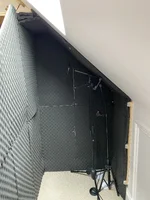B
British VO guy
New member
I refer to it as my voiceover coffin, because there's just enough room to stand up straight in it. (H2m x L1m xW 0.6m). It's in my loft room in a wardrobe area with a 3rd party wall and roof which are heavily insulated. This is the only space I can use, I can't treat the room. The sound isn't bad, a little boxy and boomy but it's a little box. An audio engineer friend suggested removing the 15mm of foam and replacing with fabric covered, Rockwool RWA45 30mm slabs, doubling it up where possible and particularly behind, above and around my head area, with the result being a less muddy sound which has only been taking out the high frequencies. I'd massively appreciate your thoughts. Would the £200 spend make a discernible difference?
edit: (416 mic pictured but also use AT4050 condenser)



edit: (416 mic pictured but also use AT4050 condenser)

Last edited:
